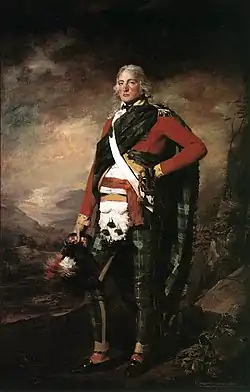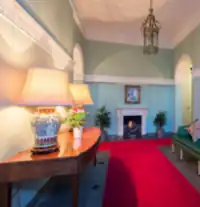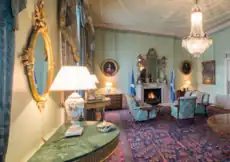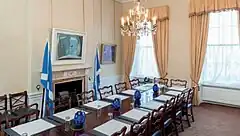| Bute House | |
|---|---|
Taigh Bhòid Buit Hoose | |
.jpg.webp) .jpg.webp) Top: Charlotte Square elevation of Bute House (Note: the door is now black) Bottom: Plaque at the main entrance to Bute House | |
| Former names | No. 6 Charlotte Square |
| General information | |
| Status | Completed |
| Type | Official residence of the First Minister of Scotland |
| Architectural style | Neoclassical |
| Address | 6 Charlotte Square |
| Town or city | Edinburgh |
| Country | Scotland |
| Coordinates | 55°57′9.360″N 3°12′29.016″W / 55.95260000°N 3.20806000°W |
| Current tenants | Humza Yousaf, First Minister of Scotland |
| Named for | The 4th Marquess of Bute |
| Construction started | 1793 |
| Completed | 1805 |
| Owner | National Trust for Scotland |
| Technical details | |
| Material | Sandstone |
| Floor count | Five |
| Floor area | 525.65 m2 (5,658.0 sq ft)[1] |
| Design and construction | |
| Architect(s) | Robert Adam |
| Developer | Lord Provost and Edinburgh Town Council |
| Website | |
| Official website | |
Listed Building – Category A | |
| Official name | 1-11 (inclusive nos) Charlotte Square with railings, lamp standards and boundary wall |
| Designated | 3 March 1966 |
| Reference no. | LB28502[2] |
Bute House (Gaelic: Taigh Bhòid) is the official residence of the First Minister of Scotland located within Charlotte Square in Edinburgh. Alongside two other personal offices at the Scottish Parliament Building and St. Andrew's House, Bute House also contains a smaller office used by the First Minister when in official residence.[3]
Located at 6 Charlotte Square in the New Town, it is the central house on the north side of the square and was designed by Robert Adam. Bute House was conveyed to the National Trust for Scotland by the Marquess of Bute in 1966. Between 1970 and 1999, it served as the official residence of the Secretary of State for Scotland. Since July 1999, it has been the official residence of the First Minister.[4]
The four-storey house contains the Cabinet Room, offices and conference, reception, sitting and dining rooms where the First Minister works and where Scottish Government ministers, official visitors and guests are received and entertained. The second and third floors contain the private residence of the First Minister. As well as serving as the official residence of the First Minister, Bute House is frequently used by the First Minister to hold press conferences, media briefings, meetings of the cabinet of the Scottish Government and appointing members to the Scottish Cabinet.[5]
History of the building
Early occupants

Charlotte Square was designed by Scottish architect Robert Adam. The Lord Provost and Edinburgh Town Council commissioned Adam to draw up plans for the square in 1791 as the culmination of Edinburgh's first New Town. However, Adam died in 1792, and his completed designs had to be realised by others. The north side of the square was built first and is faithful to his intentions.[6]
The plot where Bute House now stands was sold in 1792 by public roup (auction) to Orlando Hart, a shoemaker, prominent member of the Town Council and deacon-convener of the trades in Edinburgh, for £290.[7][8]

The house was occupied by John Innes Crawford, who lived there between 1796 and 1800.[9] He was born in Jamaica on 27 October 1776. In 1781 he inherited the Bellfield estate in St James, Jamaica, from his father, John Crawford.[9] The Bellfield sugar plantation, with its six hundred enslaved workers, generated a net income of £3,000 a year.[10][11] He later moved to 91 George Street, Edinburgh where he lived between 1801 and 1825.[9] He died on 22 November 1839.[9]
In 1806, Sir John Sinclair, 1st Baronet bought the newly completed house for £2,950.[7][8] Sinclair was a Whig politician and a writer on finance and agriculture. He was also responsible for the compilation of the First Statistical Account of Scotland. Sinclair sold the house in 1816 to Lieutenant Colonel William Gabriel Davy.[4][7][12]
In May 1818, the house was purchased from Davy by Henry Ritchie of Busbie. Ritchie was a Glasgow merchant, a partner in the Thistle Bank, and the owner of landed estates in Lanarkshire and Ayrshire.[7] He sold his Charlotte Square townhouse to Charles Oman, a hotel keeper and vintner, in May 1825.[7] Oman, a native of Caithness, had owned various hotels and coffee houses in Edinburgh over the decades, including the Waterloo Hotel on the city's Waterloo Place, up until his purchase of 6 Charlotte Square.[13] Oman turned his new townhouse into Oman's Hotel, which was to remain for over 20 years. The fixings for the letters of the hotel's name can still be seen today on the exterior wall above the front entrance door of Bute House.[4]
Oman died in August 1826, but the hotel continued to operate under the ownership of his widow, Mrs Grace Oman (née Burns). The exiled Charles X of France stayed at the hotel for a brief time in 1832, during his second period of exile in Edinburgh.[4][12][14] Following Mrs Oman's death in 1845, 6 Charlotte Square was sold by her heirs to Alexander Campbell of Cammo, who lived in the house with his family until his death in 1887.[14] Campbell commissioned David Rhind to make various alterations and additions to the house in 1867. The house's next owner was Sir Mitchell Mitchell-Thomson, 1st Baronet, who was to make it his home for the next 30 years. A partner in his family's timber business, and a director of the Bank of Scotland, he also served as the Lord Provost of Edinburgh from 1897 until 1900. In 1889, Mitchell-Thomson employed the architect Thomas Leadbetter to carry out further alterations.[4][12][14][15]
Bute family: 1922–66
The 4th Marquess of Bute had a particular enthusiasm for the amenity value of the Scottish townscape. From the early 1900s onwards, he began to buy up the central houses on the north side of Charlotte Square to restore Adam's original design, which 19th-century intrusions had compromised, including dormer windows and alterations to the proportions of the first-floor windows.[4][8] Lord Bute acquired the house at No. 5 first, in 1903, and thoroughly restored its interior in an Adam Revival style, furnishing the principal rooms with antique furniture so that it could function as the Butes' townhouse in Edinburgh. He subsequently acquired No. 6 in 1922 and No. 7 in 1927.[14] Lord Bute's enthusiasm for Charlotte Square was given permanent expression when the City of Edinburgh invoked the Town Planning (Scotland) Act 1925 to effect the Edinburgh Town Planning (Charlotte Square) Scheme Order, 1930. The Bute family thereafter moved from the house at No. 5 to the neighbouring property at No. 6, taking many of the contents of No. 5 with them.[8]
Transfer to the National Trust for Scotland
In May 1966, the Treasury accepted Nos. 5, 6 and 7 Charlotte Square in lieu of part payment of death duties on the estate of the 5th Marquess of Bute, who had died in August 1956. The three houses became the property of the National Trust for Scotland, which proposed to lease No. 6 to a new trust which would administer the house as an official residence for the Secretary of State for Scotland, as a building where he could reside when in Edinburgh and where distinguished visitors could be received and entertained. The Bute House Trust was formed in 1966 to bring this idea to fruition.[16] The Trustees raised the £40,000 required for the alteration and redecoration of the house and its furnishings. The interior decoration and colour schemes were the responsibility of Lady Victoria Wemyss and Colin McWilliam. Because funding was tight, the interior refurbishment of Bute House was dependent on a number of loans.[17]
Bute House is not owned by the Scottish Government but remains in the ownership of the National Trust for Scotland, a charitable organisation dedicated to the preservation of historic buildings and sites of natural significance across the country. The property is also legally under the supervision of the Bute House Trustees, a group whose existence was provided for in the original trust deed passing ownership from the Bute family.[17]
Official residence

From 1970 onwards, after the House was refurbished after its previous owners had given it and two adjoining houses to the National Trust for Scotland, Bute House became the grace-and-favour residence in Edinburgh of the Secretary of State for Scotland, the UK government minister charged with looking after Scotland's interests in Westminster, who remained as a resident in it until devolution in 1999.[17] It is now the setting for the weekly meeting of the Scottish Government's Cabinet, which meets in what used to be the Secretary of State's study.[17]
Willie Ross was the first Secretary of State for Scotland to occupy Bute House in May 1966.[18] The Secretary of State for Scotland ceased the ability to reside in Bute House in 1999 following the establishment of the office of First Minister of Scotland. In 1999, Donald Dewar became the first First Minister of Scotland and the first occupant of Bute House in the office of First Minister. Dewar died whilst in office in October 2000, and since then, Bute House has been occupied by successive first ministers; Henry McLeish (2000–2001), Jack McConnell (2001–2007), Alex Salmond (2007–2014), Nicola Sturgeon (2014–2023) and Humza Yousaf (2023–present).[19] A portrait of each of the first ministers are currently on display in the main staircase of Bute House.[20]
Repairs and restoration
In 2017, following extensive survey work on the condition of the building undertaken by the building's conservators, Bute House was closed for urgent repairs, with the First Minister having to decant the building until necessary work was completed. The work to Bute House was coordinated by Historic Environment Scotland, with "temporary measures" put in place for the First Minister to reside and for meetings of the Cabinet whilst the building was being restored.[21]
Rooms and features
Front door and vestibule

Bute House is unusual for an Edinburgh New Town house because it has a central front door.[22] The main entrance door for most New Townhouses would more normally be placed on the same side as the staircase. However, the central door of Bute House was a necessary function of Adam's palace front.[22][23] The wide, four-panelled entrance door is made of polished black oak. Between the top sets of panels are the brass Roman numerals "VI". Below the numerals, between the bottom sets of panels, there is a brass letter box on the left-hand side of the door and a brass door knocker on the right-hand side. The door is framed by small side windows and adorned with a semicircular fanlight window. A black ironwork fence runs along the front of the house and up each side of the flight of six steps leading up to the entrance door. The fence rises on either side of the front step to support iron gas lamps.[24]
As the vestibule does not open directly into the stairwell, Balfour Paul sought to ensure that it would not appear dark and forbidding by deciding to greet the visitor with a welcoming central chimneypiece in white marble facing the front door. The plan of the vestibule is T-shaped, with archways leading through from the right-hand and left-hand sides of the fireplace. The vestibule features a rosette ceiling, highly decorative plasterwork in the Adam Revival style, and a floor of polished flagstones in octagons and black squares.[22]
Drawing room

The room features original elaborate ceiling plasterwork, with the frieze repeating the same festoons found in the ceiling decoration. In 1923, Lord Bute and Balfour Paul complemented this ceiling by introducing new doorcases in the same Adam style, together with an inlaid chimneypiece with a central tablet depicting Venus and Cupid and vases carried by dolphins.[25] The new single-leafed doors replaced 19th-century double doors, which connected this large drawing room at the front of Bute House, to the back drawing-room that is now the cabinet room.[25] The fine gilded rococo mirror is attributed to the London cabinet-maker John Mackie. The 18th-century mirror was originally made for the drawing room of Duff House in Banffshire.[25]
Cabinet room

When Bute House was first furnished as an official residence in 1970, this room was intended as the Library or private study of the Secretary of State. With the establishment of the Scottish Government in 1999, it became the cabinet room. The room's original appearance, with its robust colour scheme picking up the brown marble of the chimneypiece, is recorded in Harry More Gordon's conversation piece portraying all the successive Secretaries of State for Scotland.[26] This room retains its original cornice, but the chimneypiece and the shaped treatment of the south wall, which replaces the 19th-century double folding doors that led into the front drawing room, were introduced in the 1920s by Lord Bute and Balfour Paul.[26]
Colin McWilliam designed a desk and a bookcase incorporating copies of the portrait medallion of Robert Adam by James Tassie for this room. The modern reproduction Georgian ladder back chairs were intended to complement the existing suite of dining chairs at Bute House. The chandelier was originally in the Butes’ dining room on the ground floor.[26]
The dining room
The dining room in Bute House today is thought to have been the original dining room used in Bute House since its construction. In 1967, the Bute House Trust commissioned the reproduction furniture in this room: the chairs are from Whytock and Reid.[27]
The cornice is thought to be original design from the original construction of the house, however, a shallow recess to allow a sideboard to be included was added at some point by Lord Bute. The gilded curtain boxes features above each of the windows in the drawing room were commissioned by Lord Bute and were modelled on designs produced by Robert Adam for the 3rd Earl of Bute’s house located in Luton.[27]
Art work to feature in the drawing room include a painting by Thomas Faed titled Sir Walter Scott and his Friends. The Millennium Silverware Collection, pieces of silverware art from fifteen of Scotland’s top silversmiths which were created to mark the reopening of the Scottish Parliament also feature in the drawing room. The silverware collection is on permanent loan to Bute House from the Scottish Goldsmiths Trust.[27]
Security and incidents
In 2002, a drunken woman was able to enter Bute House and attend a private function that was taking place within Bute House. During this incident, neither then-First Minister Jack McConnell nor his wife were in residence at Bute House.[28]
In 2004, it was reported, incorrectly, that a bomb had been found close to Bute House whilst McConnell was serving as First Minister. After an investigation, it was concluded that the suspect was indeed carrying nothing that could be deemed harmful and was later sectioned under the Mental Health Act.[28]
In 2016, a man walked up to the front door of Bute House and began to shout abuse, asking if Nicola Sturgeon was inside the building. Sturgeon was not in residence at Bute House during this incident, but the man was later found guilty of two charges of breach of the peace.[29]
As a result of further restrictions to tackle rising COVID-19 cases in Scotland, 70 protesters gathered outside Bute House to protest against further restrictions in Scotland, claiming that it was a "conspiracy theory". Four men were later arrested for breaking the coronavirus lockdown restrictions that were currently in place within the Edinburgh area at the time of the protest.[30]
Notes
- ↑ Lothian Valuation Joint Board (1 April 2017). "Bute House, 6 Charlotte Square – Summary Valuation Sheet, 2017 Revaluation". Scottish Assessors Association.
- ↑ "1-11 (Inclusive nos) Charlotte Square with railings, lamp standards and boundary walls (LB28502)". portal.historicenvironment.scot. Retrieved 10 March 2020.
- ↑ "Bute House". First Minister of Scotland.
- 1 2 3 4 5 6 "History of Bute House". Scottish Government. Retrieved 23 June 2015.
- ↑ "Bute House - Edinburgh Guide". www.edinburghguide.com.
- ↑ Bute House Guidebook.
- 1 2 3 4 5 Gifford, p. 162.
- 1 2 3 4 Bute House Guidebook, p. 3.
- 1 2 3 4 "Summary of Individual | Legacies of British Slavery". www.ucl.ac.uk. Retrieved 1 July 2022.
- ↑ Blog, Guest (15 November 2018). "Edinburgh's part in the slave trade". Historic Environment Scotland Blog. Retrieved 1 July 2022.
- ↑ Melville, Jennifer (2022). Facing our past: Interim report on the connections between the properties now in the care of the National Trust for Scotland and historical enslavement. Edinburgh: National Trust for Scotland. p. 13.
- 1 2 3 Youngson, p. 154.
- ↑ Paton, p. 283.
- 1 2 3 4 Gifford, p. 163.
- ↑ Bute House Guidebook, p. 7.
- ↑ "Bute House Trust, Registered Charity no. SC015945". Office of the Scottish Charity Regulator.
- 1 2 3 4 Bute House Guidebook, p. 4
- ↑ "History of Bute House". First Minister of Scotland.
- ↑ "History of the office". First Minister of Scotland.
- ↑ "Nicola SturgeonArchives". 6 April 2015.
- ↑ "First minister's house shut for repairs". BBC News. 23 October 2017.
- 1 2 3 Bute House Guidebook, p. 6.
- ↑ Gifford, p. 168.
- ↑ Gifford, p. 169.
- 1 2 3 Bute House Guidebook, p. 8-9
- 1 2 3 Bute House Guidebook, p. 10
- 1 2 3 Bute House Guidebook, p. 11
- 1 2 "Security alert at Bute House". BBC News Online. 10 June 2004. Retrieved 22 August 2021.
- ↑ Archive, STV News. "Police brought in after 'agitated' man's rant at Bute House". STV News Archive.
- ↑ "Four men arrested over anti-lockdown protest". 12 December 2020 – via www.bbc.co.uk.
References
- Bute House Guidebook (PDF). Edinburgh: Scottish Government. 2017.
- Gifford, John; McWilliam, Colin & Walker, David (1984). Edinburgh: The Buildings of Scotland. (Pevsner Architectural Guides.) New Haven: Yale University Press. ISBN 978-0-300-09672-9.
- Paton, Hugh (1842). A Series of Original Portraits and Caricature Etchings by the late John Kay. Edinburgh: Hugh Paton.
- Youngson, A. J. (2001). The Companion Guide to Edinburgh and the Borders. Companion Guides. ISBN 978-1-900-63938-5.
